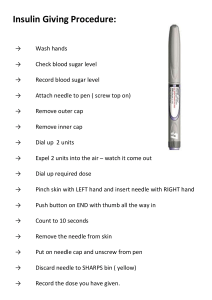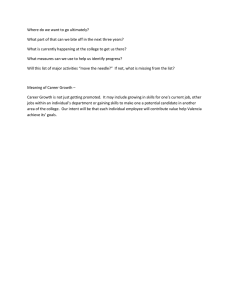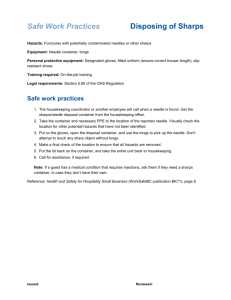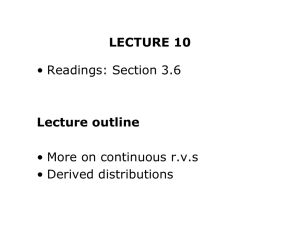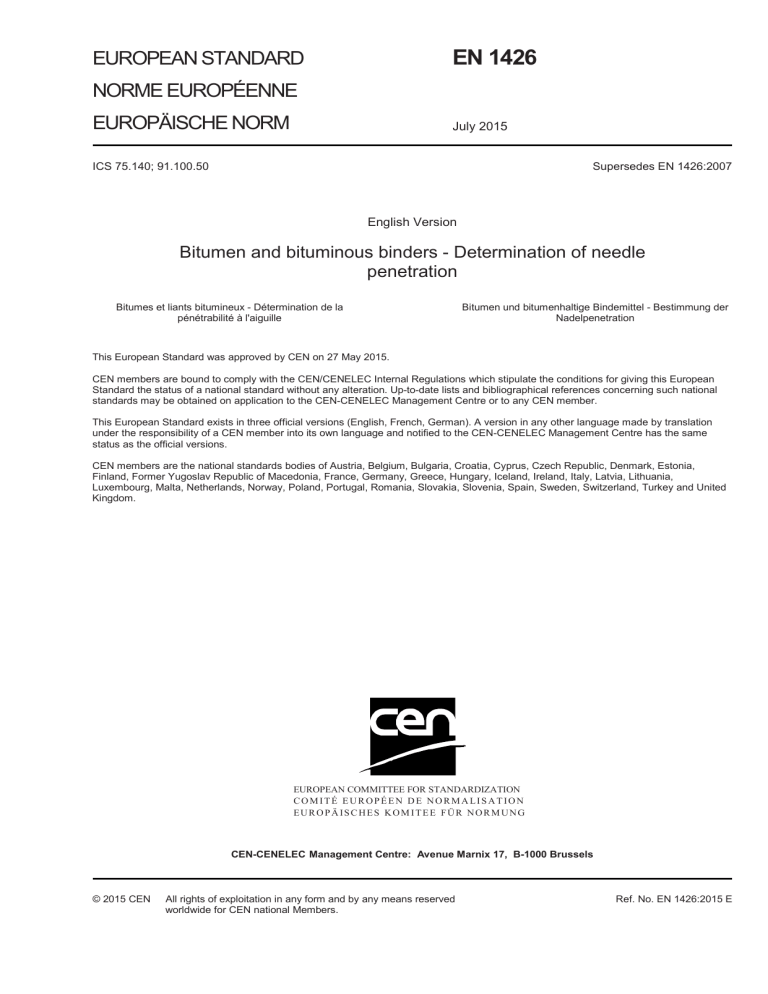
EN 1426 EUROPEAN STANDARD NORME EUROPÉENNE EUROPÄISCHE NORM July 2015 ICS 75.140; 91.100.50 Supersedes EN 1426:2007 English Version Bitumen and bituminous binders - Determination of needle penetration Bitumes et liants bitumineux - Détermination de la pénétrabilité à l'aiguille Bitumen und bitumenhaltige Bindemittel - Bestimmung der Nadelpenetration This European Standard was approved by CEN on 27 May 2015. CEN members are bound to comply with the CEN/CENELEC Internal Regulations which stipulate the conditions for giving this European Standard the status of a national standard without any alteration. Up-to-date lists and bibliographical references concerning such national standards may be obtained on application to the CEN-CENELEC Management Centre or to any CEN member. This European Standard exists in three official versions (English, French, German). A version in any other language made by translation under the responsibility of a CEN member into its own language and notified to the CEN-CENELEC Management Centre has the same status as the official versions. CEN members are the national standards bodies of Austria, Belgium, Bulgaria, Croatia, Cyprus, Czech Republic, Denmark, Estonia, Finland, Former Yugoslav Republic of Macedonia, France, Germany, Greece, Hungary, Iceland, Ireland, Italy, Latvia, Lithuania, Luxembourg, Malta, Netherlands, Norway, Poland, Portugal, Romania, Slovakia, Slovenia, Spain, Sweden, Switzerland, Turkey and United Kingdom. EUROPEAN COMMITTEE FOR STANDARDIZATION COMITÉ EUROPÉEN DE NORMALISATION EUROPÄISCHES KOMITEE FÜR NORMUNG CEN-CENELEC Management Centre: Avenue Marnix 17, B-1000 Brussels © 2015 CEN All rights of exploitation in any form and by any means reserved worldwide for CEN national Members. Ref. No. EN 1426:2015 E EN 1426:2015 (E) Contents Page Foreword ..............................................................................................................................................................3 1 Scope ......................................................................................................................................................4 2 Normative references ............................................................................................................................4 3 Terms and definitions ...........................................................................................................................4 4 Principle ..................................................................................................................................................4 5 Apparatus ...............................................................................................................................................5 6 Sampling .................................................................................................................................................7 7 Procedure ...............................................................................................................................................8 8 Expression of results ............................................................................................................................9 9 Precision .............................................................................................................................................. 10 10 Test report ........................................................................................................................................... 10 Annex A (informative) Characteristics of thermometers ............................................................................ 13 Bibliography ..................................................................................................................................................... 14 2 EN 1426:2015 (E) Foreword This document (EN 1426:2015) has been prepared by Technical Committee CEN/TC 336 “Bituminous binders”, the secretariat of which is held by AFNOR. This document supersedes EN 1426:2007. This European Standard shall be given the status of a national standard, either by publication of an identical text or by endorsement, at the latest by January 2016, and conflicting national standards shall be withdrawn at the latest by January 2016. Attention is drawn to the possibility that some of the elements of this document may be the subject of patent rights. CEN [and/or CENELEC] shall not be held responsible for identifying any or all such patent rights. The major changes to the standard at this revision have been: — the normative reference to mercury thermometers has been deleted (see 5.7 and Annex A) and — Table 1 and the description of 6.4 have been clarified and improved. Apart from this various smaller adjustments have been made. According to the CEN/CENELEC Internal Regulations, the national standards organisations of the following countries are bound to implement this European Standard: Austria, Belgium, Bulgaria, Croatia, Cyprus, Czech Republic, Denmark, Estonia, Finland, Former Yugoslav Republic of Macedonia, France, Germany, Greece, Hungary, Iceland, Ireland, Italy, Latvia, Lithuania, Luxembourg, Malta, Netherlands, Norway, Poland, Portugal, Romania, Slovakia, Slovenia, Spain, Sweden, Switzerland, Turkey and the United Kingdom. 3 EN 1426:2015 (E) 1 Scope This European Standard specifies a method for determining the consistency of bitumen and bituminous binders. Normal procedure is described for penetrations up to (330 × 0,1) mm, but for penetrations above this value, up to (500 × 0,1) mm, different operating parameters are necessary. WARNING — Use of this European Standard may involve hazardous materials, operations and equipment. This European Standard does not purport to address all of the safety problems associated with its use. It is the responsibility of the user of this European Standard to establish appropriate safety and health practices and determine the applicability of regulatory limitations prior to use. 2 Normative references The following documents, in whole or in part, are normatively referenced in this document and are indispensable for its application. For dated references, only the edition cited applies. For undated references, the latest edition of the referenced document (including any amendments) applies. EN 58, Bitumen and bituminous binders - Sampling bituminous binders EN 1425, Bitumen and bituminous binders - Characterization of perceptible properties EN 1427, Bitumen and bituminous binders - Determination of the softening point - Ring and Ball method EN 10088-3, Stainless steels - Part 3: Technical delivery conditions for semi-finished products, bars, rods, wire, sections and bright products of corrosion resisting steels for general purposes EN 12594, Bitumen and bituminous binders - Preparation of test samples EN 12597, Bitumen and bituminous binders - Terminology EN ISO 6508-1, Metallic materials - Rockwell hardness test - Part 1: Test method (ISO 6508-1) 3 Terms and definitions For the purposes of this document, the terms and definitions given in EN 12597 and the following applies. 3.1 penetration consistency, expressed as the distance in tenths of a millimetre that a standard needle will penetrate vertically into a sample of the material under specified conditions of temperature, load and loading duration 4 Principle The penetration of a standard needle into a conditioned test sample shall be measured. For penetrations up to approximately (330 × 0,1) mm the operating parameters shall be a test temperature of 25 °C, an applied load of 100 g, and a loading duration of 5 s. For penetrations expected above approximately (330 × 0,1) mm, the test temperature shall be reduced to 15 °C but the operating parameters of the applied load and the loading duration remain unchanged. Other conditions can be applied; also to reflect different purposes – e.g. 200 g, 60 s and 5 °C may be used as indicative for low temperature performance. 4 EN 1426:2015 (E) 5 Apparatus Usual laboratory apparatus and glassware, together with the following: 5.1 Penetrometer; apparatus that permits a needle holder to move vertically without measurable friction and enables the needle penetration to be determined to the nearest 0,1 mm. The needle holder shall be readily detachable from the apparatus and shall have a mass of (47,50 ± 0,05) g. A weight of (50,00 ± 0,05) g suitable for attachment to the needle holder shall be provided if not already fixed to the needle holder. The stand upon which the specimen container, or transfer dish rests shall be flat and horizontal. The 50 g weight shall be fixed underneath the support (see Figure 1). An example of a suitable penetrometer is shown in Figure 1. To facilitate levelling, the penetrometer should be provided with level adjustment screws. NOTE The use of the needle-holder of (97,50 ± 0,05) g without additional weight is also possible. Equipment that controls the penetration time automatically may also be used. Such equipment shall be checked regularly for correct penetration time (see 5.6). 5.2 Penetration needle, (see Figure 2) 5.2.1 Penetration needle specifications made from fully hardened, tempered and polished stainless steel of type X105CrMo17 (1.4125), conforming to EN 10088-3, taking into account that it is not necessary to comply with the minimum content of molybdenum specified in that standard, and of Rockwell hardness C54 to C60 determined in accordance with EN ISO 6508-1. The cylindrical body of the needle shall have a diameter of 1,00 mm to 1,02 mm and one end shall be symmetrically tapered by grinding to a cone with an angle between 8°40’ and 9°40’ over the entire cone length. The cone shall be co-axial with the cylindrical body of the needle; the total axial variation of the intersection between the conical and cylindrical surfaces shall not exceed 0,2 mm. Further dimensional details of the penetration needle see Figure 2. The conical tip of the needle shall be ground square to the axis of the needle within 2 ° until the diameter at the tip is between 0,14 mm and 0,16 mm. For penetrations up to (330 × 0,1) mm the length of the needle shall be approximately 50 mm. For penetrations between (330 × 0,1) mm and (500 × 0,1) mm, use needles that shall conform to the requirements given for mass and dimensions, but which are longer in length so that the ferrule into which the needle is fixed does not penetrate the material undergoing testing. The needle shall be rigidly mounted in a brass or stainless steel ferrule with 5 mm to 10 mm of the needle inside the ferrule. The run-out of the needle tip or any part of the needle relative to the ferrule axis shall not exceed 1,0 mm. The ferrule shall be (3,10 ± 0,15) mm in diameter and (38 ± 1) mm in length. The ferrule of the penetration needle shall fit firmly into the needle holder. The mass of the ferrule and needle assembly shall be (2,50 ± 0,05) g. NOTE 1 A drill hole at the end of the ferrule or a flat on the side is possible to control the mass. Individual identification marking shall be engraved or stamped on the ferrule of each needle; the same marking shall not be repeated by the manufacturer within a 3 year period. NOTE 2 For information concerning tolerances of the needle (Figure 2), see ISO 286-1, EN 1829, EN ISO 1101 and EN ISO 1302. 5.2.2 Continuous check of penetration needle by lab It is important that initial and continued compliance with the stringent requirements for the needle is maintained. Certification of compliance shall be obtained through the needle supplier or a qualified agency. 5 EN 1426:2015 (E) Penetration needles shall be stored adequately in a protective box. The edge of the ground tip shall be sharp and free from burrs. The needle shall be inspected visually for corrosion and shape and the masses of the needle and spindle checked sufficiently regularly to assure satisfactory condition. In case of corrosion or burrs, penetration needle shall be rejected. NOTE The verification of the conical tip of the needle can be performed with binocular magnifying glasses or a microscope. A visual control of the run-out of the needle shall be performed by rolling the needle on a table. The mass of the needle plus needle holder together with the additional mass of the weight provides a moving load of (100,00 ±0,10) g. 5.3 Test sample container, metal or glass, cylindrical, flat-bottomed. The internal depth of the container shall be appropriate in order to contain a bituminous sample of which the depth shall be at least 10 mm greater than the expected penetration, and not less than 35 mm and shall not exceed 60 mm. The internal diameter of the container shall be at least 55 mm and shall not exceed 70 mm. NOTE 1 Recommended dimensions of the test sample container are given in Table 1. Table 1 — Informative - Recommended dimensions of the test sample container (see normative details in 6.4) Approx. volume of sample Approx. cooling time in air or conditioning time in water (mL) (min) 55 80 60 45 70 170 75 60 70 230 90 Internal depth Internal diameter (mm) (mm) penetration < 160 35 160 ≤ penetration < 330 330 ≤ penetration ≤ 500 Penetration (0,1 mm) If insufficient binder is available (e.g. if it was obtained by extraction of a bituminous mix core or while monitoring short- or long-term ageing development) use a small stainless steel container. In order to fulfil the requirements of 7.4.2, the container shall have an inner diameter of at least 35 mm and a wall thickness between 1,5 mm and 2,0 mm. For penetrations lower than (100 x 0,1) mm, the inner height of the container shall be at least 20 mm. For penetrations from (100 x 0,1) mm up to (200 x 0,1) mm, the inner height of the container shall be at least 30 mm. To ensure a good stable temperature during testing, the container shall be placed in a brass ring with an inner diameter within 0,5 mm of the outer diameter of the sample container and a height of (21 ± 1) mm or (31 ± 1) mm. Report deviation from standard test conditions under Test report e). NOTE 2 Clause 9. The precision of the penetration values determined using the metal ring can be different from those given in 5.4 Water bath (constant temperature bath), with a capacity of at least 10 l, and able to maintain the temperature of the test sample within ± 0,15 °C. The bath shall have a perforated shelf supported in a position not less than 50 mm from the bottom and not less than 100 mm below the liquid level in the bath. If penetration tests are to be made in the bath itself, an additional shelf, strong enough to support the penetrometer shall be provided. 6 EN 1426:2015 (E) The use of distilled or deionized water is recommended for the bath. Care should be taken to avoid contamination of the bath water by active surface agents or any other material that can affect the penetration values. 5.5 Transfer dish, for tests outside the water bath. The dish shall have a capacity of at least 350 ml and shall be deep enough to ensure that the test sample container is completely covered with water. The bottom of the transfer dish shall be constructed so that the dish cannot be rocked when it is placed on the stand of the penetrometer. Similarly the surface on which the test sample container rests shall be made so that the test sample container cannot rock during penetration of the test sample. For temperatures lower than 25 °C, the capacity of the transfer dish shall be at least 1,5 l. 5.6 Timing device, capable of measuring the instant of release of the equipment and the duration of the test to 0,1 s. 5.7 Temperature measuring device A temperature measuring device (combining sensor and reading unit) shall • have a range from at least 0 °C to 30 °C • be readable to 0,1 °C or less and • have an accuracy of 0,1 °C or better. Sensors based on platinum resistance thermometers have been found suitable but other principles are also allowed. The temperature measuring device shall be calibrated regularly. A solid stem mercury thermometer (which used to be the former reference thermometer as described in Annex A ) is also allowed if national regulations permits its use. When measuring and controlling nominally constant temperatures, as in the method described, the thermal response time can be rather high (e.g. slow response to a change in temperature). Care shall be taken to consider this aspect since low thermal response times of the sensor can indicate greater cyclic variations than the bituminous material in practise experiences. 5.8 6 Calibration/Verification, all equipment shall be calibrated/verified at least once per year. Sampling 6.1 Take the laboratory sample in accordance with EN 58, taking all necessary safety precautions, and ensuring that the test sample is representative of the laboratory sample from which it is taken. Ensure that the laboratory sample is homogeneous and is not contaminated (see EN 1425). 6.2 Remove a sufficient amount of the laboratory sample, if necessary using a warmed knife, and transfer it to a suitable container. Melt the sample according to EN 12594. 6.3 Raise the material to the required temperature of not more than 100 °C above the expected softening point (see EN 1427) and fill one clean (free of dust, grease, rust, etc...) test sample container (5.3). Fill the container with the homogenised sample to a depth so that, when the test sample is cooled to the test temperature, the depth is 10 mm greater than the depth to which the needle is expected to penetrate. For polymer modified bitumen follow the procedure provided by the supplier. If no other guidance is provided by the supplier for polymer modified bitumen according to EN 14023 the temperature shall be within 180°C to 200°C. The temperature shall not exceed 200 °C irrespective of the softening point. 7 EN 1426:2015 (E) 6.4 Immediately after filling, loosely cover the test sample container with a container such as a lipped beaker of suitable size. NOTE 1 This assists in eliminating any air bubbles and it is a convenient way of providing protection against dust. Allow the test sample to cool at an ambient temperature between 15 °C and 30 °C: • For test samples < 45 mm depth − cool for 60 min to 90 min • For test samples 45 - 60 mm depth − cool for 90 min to 120 min • For test samples with volume > 180 ml - cool for 60 - 90 min for each 100 ml of test sample. Place the test sample in the constant temperature bath for a similar period to that used for cooling, and start testing. NOTE 2 To avoid uneven surfaces of samples of hard bitumen according to EN 13305 after cooling, place the sample container filled with hot bitumen into the oven at a temperature of approximate 80 °C for a period of 15 to 30 min. Then cool to ambient temperature and continue as described in this standard. NOTE 3 For measurement at temperatures lower than 25 °C, longer cooling times can be required. 6.5 When test conditions are not specified, for penetration values below approximately (330 × 0,1) mm, the temperature, total applied load and loading duration shall be 25 °C, 100 g and 5 s. For penetration values above approximately (330 × 0,1) mm, the test shall be carried out at conditions of 15 °C, 100 g and 5 s. When other conditions are used, the details shall be reported in full. NOTE In this case, the precision can be different from that stated in Clause 9. The temperature of the sample has a significant influence on the test result. Duration and circumstances to achieve the test temperature shall be documented accurately under Test report e). 7 7.1 Procedure Preparation of the needle holder and needles Examine the needle holder and its guide to check that it is free of water and other extraneous matter. Ensure that the needle holder moves freely in its guide. Clean a penetration needle with suitable solvent e.g. xylene, dry with a clean cloth and insert the needle into the needle holder. Unless otherwise specified, add the 50 g weight and ensure that the total applied load is (100,00 ± 0,10) g. 7.2 Tests in the constant temperature bath If tests are made with the penetrometer in the bath, place the test sample container directly on the submerged shelf of the penetrometer. Keep the test sample container completely covered with the water in the bath. 7.3 Tests outside the constant temperature bath If tests are made with the penetrometer outside the bath, place the sample container in the transfer dish that has been kept in the bath with the test samples, cover the test sample container completely with water from the constant temperature bath, and place the transfer dish on the stand of the penetrometer. Make sure that the transfer remains at the chosen temperature until the measurement is completed. Start the testing at latest one minute after removing the transfer dish from the water bath. 8 EN 1426:2015 (E) For reference tests, make penetrations at temperatures other than 25 °C without removing the test samples from the bath unless the transfer dish is separately controlled to ensure the correct temperature. 7.4 Determination of the penetration 7.4.1 First determinations With the test sample container in position, slowly lower the needle until its tip just makes contact with its image reflected by the surface of the test sample. Ensure that the zero position of the needle is noted, then, quickly release the needle holder for the specified period of time. If the container moves during the determination, discontinue the test. Adjust the instrument as necessary to determine the penetration of the needle into the sample in tenths of a millimetre. NOTE 7.4.2 The positioning of the needle can be aided materially by good illumination with a cold light source. Repeat determinations Carry out at least three valid determinations with three separate needles at points on the surface of the test sample that are not less than 10 mm from the sides of the container and are not less than 10 mm apart. Use a clean needle for each determination. If the penetration is greater than (100 × 0,1) mm, leave all the needles in the test sample until all the determinations have been completed. If necessary move the first two needles without disturbing the surface. If the test is carried out outside the bath and the three determinations are not carried out according to the temperature tolerance, return the test sample and transfer dish to the bath and repeat the determination(s). 7.5 Maximum range of valid determinations For tests carried out under the conditions of a test temperature of 25 °C, a total applied load of 100 g and a loading duration of 5 s, the three determinations shall be acceptable if the range of the results obtained does not exceed the relevant value given in Table 2. Table 2 — Maximum range of the valid determinations NOTE Penetration in 0,1 mm up to 49 50 to 149 150 to 249 250 and above Maximum difference between highest and lowest determinations 2 4 6 8 These ranges are not necessarily applicable at other conditions. If the appropriate maximum difference is exceeded, discard the results and repeat the test from Clause 6 on a second sample test container. If the appropriate range is again exceeded, ignore all determinations and repeat the test until three valid determinations have been obtained on the same test sample. 7.6 After completing the test, clean the penetration needles with a suitable solvent and store so as to prevent corrosion or damage. Do not use detergent or silicone oil for cleaning the needles. 8 Expression of results Express the penetration value as the arithmetic mean of the acceptable determinations (see 7.5), in tenths of a millimetre rounded to the nearest integer. 9 EN 1426:2015 (E) 9 Precision 9.1 Repeatability The difference between two test results obtained by the same operator with the same apparatus under constant operating conditions on identical test material would, in the long run, in the normal and correct operation of the test method, exceed the values given in Table 3 in only one case in twenty. 9.2 Reproducibility The difference between two single and independent test results obtained by different operators working in different laboratories on identical test material would, in the long run, in the normal and correct operation of the test method, exceed the values given in Table 3 in only one case in twenty. Table 3 — Precision Operating conditions Penetration in 0,1 mm Repeatability, r Reproducibility, R 25 °C < 50 2 3 100 g ≥ 50 4 % of the mean value 6 % of the mean value ≥ 50 5 % of the mean value 8 % of the mean value 5 °C < 50 2 4 200 g ≥ 50 9 % of the mean value 13 % of the mean value 5s 15 °C 100 g 5s 60 s NOTE These precision data are not necessarily applicable at other conditions. 10 Test report The test report shall contain at least the following information: a) type and complete identification of the sample under test; b) reference to this European Standard; c) type of apparatus (manual, automatic); d) result of the test (see Clause 8); e) any deviation, by agreement or otherwise, from the procedure specified; f) date of the test. 10 EN 1426:2015 (E) Key 1 spindle 2 dial assembly 3 needle holder 4 release assembly 5 50 g mass 6 needle and ferule 7 transfer dish with flat bottom 8 test sample container 9 base plate (stand) 10 level adjustment screw Figure 1 — Example of penetrometer 11 EN 1426:2015 (E) All dimensions in millimetres The radial run out shall not be greater than 1 mm in any plane of measurement during one revolution about the datum axis A-B. The axis of the cylinder, to which the tolerance frame is connected, shall be contained in a cylindrical zone of diameter 0,2 mm with the datum axis C-D. The axis of the needle (CD) and the axis of the ferrule (AB) shall be coaxial within 0,2 mm. Figure 2 — Needle for penetration test 12 EN 1426:2015 (E) Annex A (informative) Characteristics of thermometers Temperature range °C - 8 to + 32 19 to 27 25 to 55 Subdivision °C 0,1 0,1 0,1 Long lines at each °C 0,5 0,5 0,5 Numbers at each °C 1 1 1 Max. scale error °C 0,1 0,1 0,1 Total Total Total 80 100 105 Scale marks Immersion Expansion chamber permits heating to temperature °C Total length mm 374 to 384 270 to 280 374 to 384 Stem outside diameter mm 7,0 to 8,0 6,0 to 7,0 7,0 to 8,0 Bulb length mm 25 to 35 25 to 35 25 to 35 Bulb outside diameter mm 6,0 to 7,0 6,0 to 7,0 > 5,0 and not greater than stem between bottom of bulb to line at °C -5 19 25 Distance mm 77 to 98 135 to 150 115 to 135 Length of scale mm 239 to 289 67 to 101 189 to 229 Scale location NOTE The thermometers ASTM 63C, 17C and 64C were found suitable for the different temperature ranges provided national regulations allow the use of mercury stem thermometers. 13 EN 1426:2015 (E) Bibliography [1] EN ISO 286-1, Geometrical product specifications (GPS) - ISO code system for tolerances on linear sizes - Part 1: Basis of tolerances, deviations and fits (ISO 286-1) [2] EN ISO 1101, Geometrical product specifications (GPS) - Geometrical tolerancing - Tolerances of form, orientation, location and run-out (ISO 1101) [3] EN ISO 1302, Geometrical Product Specifications (GPS) - Indication of surface texture in technical product documentation (ISO 1302) 14

